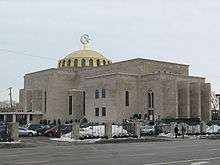Hamaas Abdul Khaalis
Hamaas Abdul Khaalis (1921–2003), born Ernest Timothy McGhee, also known as Ernest "XX" McGee and Ernest 2X McGee, was leader of the Hanafi Movement, an African-American Muslim group based in Washington, D.C. subscribing to the Hanafi school of Sunni Islam. To draw attention to the 1973 murder of his family he organised a 1977 siege in which two of 149 hostages died. He spent the rest of his life in prison after being found guilty of conspiracy to commit kidnapping while armed, second-degree murder, two counts of assault with intent to kill while armed, one count of assault with a dangerous weapon, and 24 counts of kidnapping while armed.[1]
Hamaas Abdul Khaalis | |
|---|---|
| Khalifi of Hanafi Madh-Hab Center in Washington D.C. | |
| In office 1958–2003 | |
| Preceded by | Tasibur Uddein Rahman |
| Personal details | |
| Born | Ernest Timothy Mcgee 1921 |
| Died | 2003 |
| Occupation | Khalifi of Hanafi Madh-Hab Center in Washington D.C. |
| Part of a series on: |
| Nation of Islam |
|---|
 |
|
Influencers |
|
History
|
|
Related organizations |
|
|
Early life
Khaalis was born to Seventh-day Adventist[2] parents in Gary, Indiana[3] as Ernest Timothy McGhee. He graduated 22nd in a class of 135 at Roosevelt High School, and he played percussion instruments and eventually converted to Roman Catholicism.[3] As McGee, he attended Purdue University and Mid-Western Conservatory. Discharged from the U.S. Army on grounds of mental instability,[4] he was a talented jazz drummer and played with Bud Powell, Charlie Parker, Max Roach, Billie Holiday, and J.J. Johnson in New York City.[5][2]
Hanafi Movement
Khaalis met Tasibur Uddein Rahman[3] and converted to Sunni Islam. Upon advice of his instructor, he infiltrated the Nation of Islam (NOI).[3] In 1954, at the suggestion of Malcolm X, Elijah Muhammad named Khaalis the National Secretary of the NOI, a position he held until 1957. Muhammad also sent him to Chicago to head the University of Islam.[5] In an interview, Khaalis said, "Elijah once said that I was next in line to him, that it was me, not Malcolm X."[3]
Khaalis split with the Nation of Islam in 1958 to found a rival Islamic organisation, the Hanafi Movement.[6] In 1968, he was arrested for attempted extortion but released on grounds of mental illness.[7] The same year, militant blacks at Howard University formed a group called the Kokayi family; when that was disbanded, many of its members became members of Hamaas' Hanafi American Mussulman's Rifle and Pistol Club, which was given a group membership charter by the National Rifle Association.[8]
In 1971, Khaalis converted basketball player Lew Alcindor to Islam; after his conversion, Alcindor adopted the name Kareem Abdul-Jabbar.[9] Abdul-Jabbar donated a field stone mansion, 7700 16th Street NW, to serve as the headquarters of Khaalis' organization in Washington, D.C.[10]
Feud with Nation of Islam
In 1972, Khaalis circulated an open letter that referred to Elijah Muhammad as a "lying deceiver" and asserted that he lured "former dope addicts and prostitutes to monk-like lives of sacrifice" that would "lead them to hell."[11]
Khaalis claimed credit for Malcolm X's leaving the Nation of Islam.[2] In a 1973 interview, Khaalis said he was teaching Malcolm X about Sunni Islam.[3] "He used to come to my house on Long Island and we would sit in his car for hours. He would meet me after he left the temple. Never in public because he knew they were after him. He was saying the wrong things."[3]
Murder of his family
On January 18, 1973, Khaalis' family was murdered inside their Washington D.C home, in retaliation for letters that Khaalis had written against the Nation of Islam.
Hanafi Siege
To bring attention to his family's murder, Khaalis planned and led the 1977 Hanafi Siege.[7] He was tried and convicted, receiving a sentence of 21 to 120 years in prison.
Death
Khaalis died in prison in 2003.[12]
Published works
- "Look and See The Key to Knowing and Understanding – Self-Identity, Self-Culture and Self-Heritage" A.S.F.M.I., 1972.
References
- "Khaalis v. United States". Justia US LAW. Retrieved March 11, 2017.
- Meyer, Eugene; Whitaker, James; Colen, B.D. (March 11, 1977). "Tiny Hanafi Sect's Followers Devoted, U.S.-Born Converts". Washington Post. Retrieved March 10, 2017.
- Delaney, Paul (January 31, 1973). "Rival Leader Tells of Efforts to Convert Black Muslims". The New York Times. Retrieved March 10, 2017.
- Jones, Mark (March 14, 2014). "The Hanafi Siege of 1977". Boundary Stones. WETA. Retrieved August 10, 2019.
- Evanzz, Karl (January 9, 2001). The Messenger: The Rise and Fall of Elijah Muhammad. Knopf Doubleday Publishing Group. p. 164. ISBN 978-0679774068.
- "Media Guide to Islam". Mediaguidetoislam.sfsu.edu. Archived from the original on June 3, 2010. Retrieved June 13, 2010.
- "The 38 Hours: Trial by Terror". Time magazine. March 21, 1977. Retrieved March 12, 2007.
- Charlton, Linda (March 10, 1977). "GUNMEN LINKED TO A MOSLEM SECT INVADE 3 BUILDINGS IN WASHINGTON, KILL 1 AND HOLD SCORES HOSTAGE". Retrieved March 11, 2017.
- Abdul-Jabbar, Kareem (March 29, 2015). "Why I converted to Islam". Al Jazeera America. Retrieved November 21, 2018.
- Meyer, Eugene; Edwards, Paul (March 10, 1977). "Barry 'A Very Lucky Man'". The Washington Post. Retrieved November 21, 2018.
- Gardell, Mattias (1996). In the Name of Elijah Muhammad: Louis Farrakhan and The Nation of Islam. Duke University Press. p. 189. Retrieved March 12, 2017.
- Davis, Aaron (March 11, 2017). "When Terrorists Took D.C. Hostage". The Washington Post.